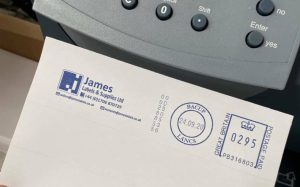Get Franking Quotes Today
Simply fill out the online form to get your FREE quotes from Leading Franking Suppliers.
✔ Free No Obligation quotes
✔ Compare prices from Leading Suppliers
✔ Instant call backs
While franking machines have long been a staple in managing postage for businesses, they aren’t without their drawbacks. Despite their convenience and cost-saving benefits, these machines come with a set of disadvantages that users should consider before integrating them into their operations.
One of the primary disadvantages of using a franking machine is the initial cost outlay. Acquiring a franking machine involves an initial investment that includes the purchase or lease of the machine itself. For smaller businesses or startups with limited budgets, this upfront expense can be a significant consideration. Additionally, maintenance costs, ink refills, and software updates add to the ongoing expenses associated with these machines.
Another notable drawback is the need for regular maintenance and servicing. Like any piece of equipment, franking machines require periodic maintenance to ensure optimal performance. Ink cartridges need replacement, and the machine’s components may require cleaning or repair. These maintenance tasks can result in downtime, impacting the efficiency of mail processing and potentially causing delays in sending out important correspondence.
Discounted Rates
Furthermore, while franking machines offer discounted postage rates compared to traditional stamps, they come with restrictions. Postal authorities often regulate the use of franking machines, including specific guidelines on the size, weight, and format of mail that can be processed using these machines. Failure to comply with these regulations can result in additional fees or penalties, adding complexity to the mailing process.

Security concerns also rank among the disadvantages of franking machines. These machines handle sensitive information such as postage amounts and mailing addresses. If not properly secured, they can be susceptible to tampering or unauthorized use, leading to potential financial losses or data breaches for the business.
Moreover, the flexibility of franking machines might be limited compared to other postage methods. Changes in postage rates or regulations may require updates to the machine’s software or settings, which might not always be immediate. This can lead to inaccuracies in postage calculation or delays in adapting to new postal requirements.
Another aspect to consider is the scalability of franking machines. As businesses grow and their mailing needs expand, the capacity of a franking machine might become insufficient. Upgrading to a larger machine or accommodating increased mail volumes can incur additional costs and complexities, impacting budget allocations and operational efficiency.
Additionally, franking machines might not be suitable for occasional or sporadic mailers. Small businesses or individuals who send out minimal mail volumes might find the investment in a franking machine unjustifiable. In such cases, alternative postage methods like online postage services or purchasing stamps on an as-needed basis might be more cost-effective.
Conclusion
In conclusion, while franking machines offer numerous advantages in terms of efficiency, cost savings, and convenience, they come with several disadvantages that users should carefully consider. The initial investment, ongoing maintenance costs, regulatory restrictions, security concerns, and limited scalability are among the key factors that businesses need to weigh before committing to using a franking machine for their postage needs.